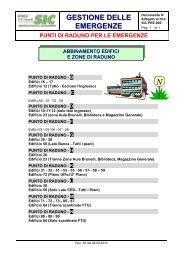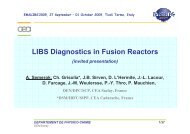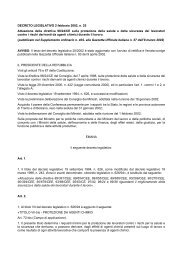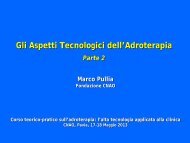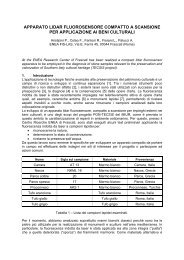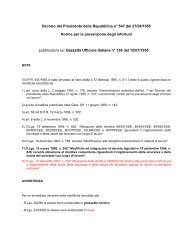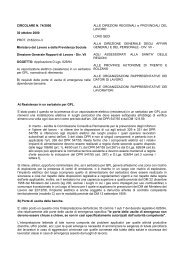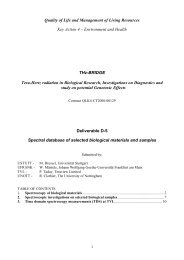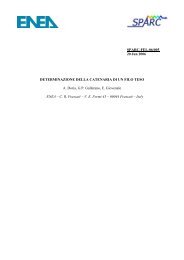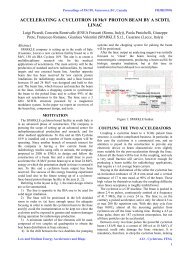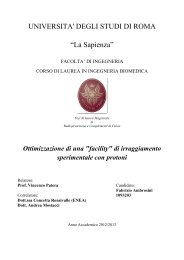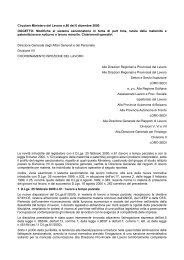Theory, Design and Tests on a Prototype Module of a Compact ...
Theory, Design and Tests on a Prototype Module of a Compact ...
Theory, Design and Tests on a Prototype Module of a Compact ...
You also want an ePaper? Increase the reach of your titles
YUMPU automatically turns print PDFs into web optimized ePapers that Google loves.
56 4. CIRCUIT MODEL<br />
matrix <strong>of</strong> the whole chain is<br />
Ttot = ˙ T N + ˙ T N−1<br />
N<br />
ε + p +<br />
p=1<br />
cosh x<br />
sinh x<br />
N<br />
ε + p [♥ + ♦] +<br />
p=1<br />
N<br />
p=1<br />
ε − p ♣ (4.46)<br />
where the symbols represent the following matrices<br />
⎛<br />
sinh (N − 1)x<br />
⎞<br />
jωM sinh x cosh (N − 1)x<br />
♥ = ⎝<br />
⎠<br />
cosh (N−1)x<br />
sinh (N − 1)x<br />
jωM sinh x<br />
⎛<br />
⎞<br />
− sinh (2p − N − 1)x jωM sinh x cosh (2p − N − 1)x<br />
♦ = ⎝<br />
⎠<br />
− cosh (2p−N−1)x<br />
jωM sinh x<br />
⎛<br />
cosh (N − 2p + 1)x<br />
sinh (2p − N − 1)x<br />
⎞<br />
jωM sinh x sinh (N − 2p + 1)x<br />
♣ = ⎝<br />
⎠<br />
− cosh (N − 2p + 1)x<br />
sinh (N−2p+1)x<br />
− jωM sinh x<br />
It is apparent that the matrix (4.46) has an imperturbed term, a perturbed<br />
<strong>on</strong>e not depending <strong>on</strong> the errors positi<strong>on</strong>s al<strong>on</strong>g the chain <str<strong>on</strong>g>and</str<strong>on</strong>g><br />
two terms that depend instead.<br />
3. The perturbed res<strong>on</strong>ant frequency<br />
The res<strong>on</strong>ant frequencies <strong>of</strong> the whole chain can be obtained from<br />
the zeros <strong>of</strong> the element <strong>of</strong> place (1, 2) in the transmissi<strong>on</strong> matrix,<br />
representing the chain impedance seen from <strong>on</strong>e side when the opposite<br />
side is short-circuited.<br />
We mainly refer to the π/2 mode <str<strong>on</strong>g>and</str<strong>on</strong>g> want to analyze the effect<br />
<strong>of</strong> the errors <strong>on</strong> the res<strong>on</strong>ant frequency that goes from ω0 to<br />
ω = ω0 + ∆ω. We can represent this situati<strong>on</strong> by a functi<strong>on</strong>: ∆ω =<br />
F (δω01, δω02, . . . , δω0N). We obtain the expressi<strong>on</strong> for the element (1, 2)<br />
from the formula (4.46) which is<br />
<br />
N<br />
<br />
i=1<br />
Ti<br />
12<br />
= h(ω, δω01, . . . , δω0N) = g(ω0 + ∆ω, ε L p , ε R p )<br />
<str<strong>on</strong>g>and</str<strong>on</strong>g> then the res<strong>on</strong>ant frequency can be seen as an implicit functi<strong>on</strong><br />
g(ω0+∆ω, ε L p , ε R p ) = 0, the soluti<strong>on</strong> <strong>of</strong> which is the perturbed frequency<br />
we are looking for. In that case we deal with<br />
g(ω0 + ∆ω, ε L p , ε R p ) = f(j π<br />
2 + ∆x, εL p , ε R p ) = 0<br />
It could be c<strong>on</strong>venient to calculate ∆x which is the error <strong>of</strong> x, rather<br />
than directly calculate ∆ω. Let us exp<str<strong>on</strong>g>and</str<strong>on</strong>g>, up to the first order, the<br />
functi<strong>on</strong> f around the imperturbed value ∆x = 0, namely x = x0 = j π<br />
2



